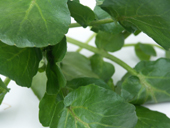
•
UK/Ireland
Canada/USA
________________________________________________________________________

eat
WATERCRESS
Raw watercress adds
a peppery yet smooth edge to dishes and is highly nutritious. Use it in
salads in place of the ubiquitous rocket, or try a watercress and Marmite
sandwich. It is a classic soup ingredient and when cooked has a milder
flavour. It's also a great in juices and gives carrot-based drinks a lovely
bite.
HISTORY
Watercress has been cultivated since Roman times. It is referred to in Irish poetry from the 12th century and has been grown in southern England since the early 1800s. Watercress was once popular as a tea, freshly made with lemon and sugar, and it has been used throughout history in Europe and Asia as a tonic for various ills.
BIOLOGY
A member of the mustard family and related to garden cress. Watercress is a fast growing semi-aquatic plant that thrives in slightly alkaline water.
NUTRITION
Watercress is rich in vitamin C, calcium, iron and folic acid. It is a cruciferous plant containing anti-cancer phytochemicals such as beta-carotene and flavonoids. Julie (Nutritional Therapist) writes: consumption of this leaf can help improve liver function and kidney function.
TIPS
BUYING
Look for crisp leaves with a deep green colour.
STORING
Watercress is very perishable but can be kept in good condition for a
couple of days by refrigerating it stems-down in a glass of water, covered
with a plastic bag.
PREPARING
Wash thoroughly just before use.
OTHER STUFF
The proper name for watercress is Nasturtium officinale. Nasturtium is Latin for 'nose twister', a reference to the plant's pungency.
PICK OF THE RECIPES
in
season:
january
february
march
april
may
june
july
august
september
october
november
december
Central London
locale
Pastry, pasta,
puds and lots more!
Fun and deliciously
different
www.cookeryschool.co.uk

A
contract catering
company that puts
quality and freshness first
www.artizian.co.uk
ONLINE
IN PRINT
-
Pitta Bread with Chickpea Puree and Alfalfa
Blanc Vite -
Watercress, Spinach and Parmesan Salad with Cider Vinegar and Mustard Dressing
Open Rhodes Around Britain -
Watercress Salad with Croutons
Leiths Cookery Bible
© 2004-2010 eat the seasons | contact @ eattheseasons.co.uk | about

